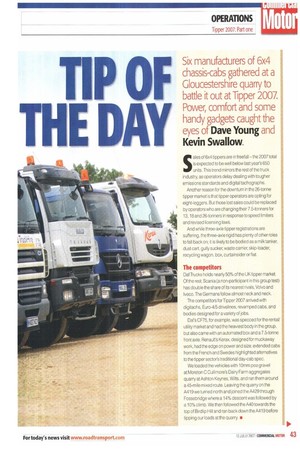P OF
Page 43

If you've noticed an error in this article please click here to report it so we can fix it.
THE
Six manufacturers of 6x4 chassis-cabs gathered at a Gloucestershire quarry to battle it out at Tipper 2007.
Power; comfort and some handy gadgets caught the
eyes of Dave Young and
Kevin Swallow.
Sales of 6x4 tippers are in treefall — the 2007 total is expected to be well below last year's 650 units. This trend mirrors the rest of the truck industry, as operators delay dealing with tougher emissions standards and digital tachographs.
Another reason for the downturn in the 26-tonne tipper market is that tipper operators are opting for eight-leggers. But those lost sales could be replaced by operators who are changing their 7.5-tonners for 13, 18 and 26-tonners in response to speed ['miters and revised licensing laws.
And while three-axle tipper registrations are suffering, the three-axle rigid has plenty of other roles to fall back on; it is likely to be bodied as a milk tanker, dust cart, gully sucker, waste carrier, skip-loader, recycling wagon. box, curtainsider or flat.
The competitors Daf Trucks holds nearly 50% of the UK tipper market. Of the rest; Scania (a non-participant in this group test) has double the share of its nearest rivals, Volvo and Iveco. The Germans follow almost neck and neck.
The competitors for Tipper 2007 arrived with digitachs, Euro-4/5 drivelines, revamped cabs, and bodies designed for a variety of jobs.
Daf's CF75, for example, was specced for the rental/ utility market and had the heaviest body in the group, but also came with an automated box and a 7.5-tonne front axle. Renault's Kerax, designed for muckaway work, had the edge on power and size; extended cabs from the French and Swedes highlighted alternatives to the tipper sector's traditional day-cab spec.
We loaded the vehicles with lOmm pea gravel at Moreton C Cullimore's Dairy Farm aggregates quarry at Ashton Keynes, Wilts, and ran them around a 45-mile mixed route. Leaving the quarry on the A419 we turned north and joined the A429 through Fosseb ridge where a 14% descent was followed by a 10% climb. We then followed the A40 towards the top of Birdlip Hill and ran back down the A419 before tipping our loads at the quarry. •
























































































































































































